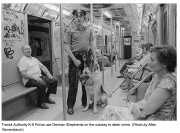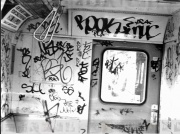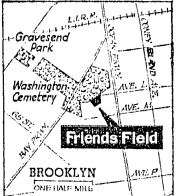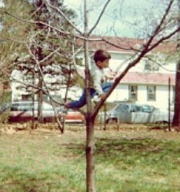A Counter to Drug Use and Street CrimeFrom The Peopling of New York CityGo back: Friends Forever -- Prologue: Sounder Bodies and Surer Morals
A Counter to Drug Use and Street CrimeIt's the 1970s in Brooklyn, NY. Let's get into the mood of the city at the time with a brief clip of "American City Suite," by Cashman and West.
People going, coming I think of all the A junkie steals, a mayor deals Of the daily news They tell me The hands that used to And her eyes are closed This is a love song, a song about a love affair between the singer and the city of New York. Composed of four songs meshed together, Cashman and West composed "American City Suites" in 1972 after watching the deterioration of many Eastern cities, especially New York. The song, of which I provided select lyrics above, traces a happy childhood in the city ("Sweet City Song"), going away to school and coming back to see a changed city ("Hello Jack" and "All Around the Town"), and finally, the death of the beloved city ("A Friend is Dying").[3]
While the city did not really die, to many people in the 1970s it seemed that New York City was near collapsing. Crime, violence, and drug wars had taken their toll on the concrete sidewalks and the city budget. As the city teetered on the brink of bankruptcy, the number of homeless swelled and pubic services disintegrated.[4] Lawbreakers were emboldened by the turmoil: In 1968, violent crime in New York was at 98,515; by 1971, a mere three years later, it had risen by over twenty-six thousand to 124,613. And by 1972, cases of rape nearly doubled from the 1968 rate of 2,527 to 4,199 cases.[5] Murder rates alone increased from 6.5 per 100,000 persons (1968) to 9.9 (1971).[6]  Transit Authority K-9 Police use German Shepherds on the subway to deter crime. Photo credit: Allan Tannenbaum[7] In the 1970s, the Dow Jones Industrial Average closed over 1,000 for the first time in its history [8], but when it dropped to 717 points, hundreds of construction workers marched to the New York Stock Exchanged and brutally and violently interrupted a Vietnam War protest; chaos reigned in the city streets.[9][10]
 Subway graffiti inside a West End line train in 1977. Photo credit: Whiskeygonebad on flickr [11] Graffiti, crime, and drugs were just a few of the problems facing the city in the early to late 1970s. The 1970s was the time the oil embargo, imposed by the Organization of Arab Petroleum Exporting Countries (Arab members of OPEC, and Egypt and Syria). It was "no gas today" and petroleum rationing.[12]
It was the time of the Rockefeller Drug Laws, which, passed in 1973, were a set of severe anti-drug laws, intended to combat the growing drug problem the city faced: "to deter citizens from using or selling drugs and to punish and isolate from society those who were not deterred."[13]
In the 1970s, Nixon went to China[14], and a postage stamp cost eight cents.[15] Apollo 17 flew to the moon[16], and Roe v. Wade legalized abortion. It was a time of conflict and growth for the United States. And in one small corner of Brooklyn, NY, a group of concerned citizens began to worry. The Brooklyn Friends school, which owned a small piece of land in Midwood, Brooklyn, had moved out of its old building at 110 Schermerhorn Street in 1970.[17] Their new facilities at 375 Pearl Street were more capacious, but in need of repairs to the tune of at least 1.5 million dollars.[18] To raise the money required, the school chose to put their athletic fields, already difficult to maintain because of frequent vandalism[18], up for sale. They planned to sell the field to a private developer or to the Board of Ed, which was being lobbied by Community Board 21 to build a new school on the plot of land. [19] But local citizens were upset over the possible development of one of the few open spaces in the neighborhood. In a hearing held at the Borough Park YMHA, the community expressed their concerns. As the city around them was folding under crime, and teen drug use becoming rampant, many active members of the community – clergy, Little League organizers, parent leaders, high school students– talked about the park land as “a counter to [the] drug use and street crime”[19] widespread in the rest of the city. Rabbi Irving Ebert spoke of “kids roaming the streets” in boredom. Without a park to go to for recreation, might they not instead turn to crime and violence?[19]
 Grace Slick and the Jefferson Starship perform in Central Park. Photo credit: Allan Tannenbaum[20] Public parks have a long history of being place of both protest and childhood joy. As community pressure increased on the Friends school, concerned residents began to form small neighborhood organizations. With names like NICE (Neighbors and Community Effort) and the Committee to Save the Preservation of Friends Field, the groups sounded as peaceful and community oriented as the Friends School itself. But something was obviously wrong: A Society of Friends was selling precious park land to private developers, and the Department of Parks was reluctant to buy it.[19] With the city dragging its feet, residents of Midwood gathered to protest the sale of their part-time park. They presented Borough President Sebastian Leone with a petition of 3000 signatures. They wanted the city to buy the park, "an integral part of the neighborhood."[21] But the political infighting between the city Parks Department, the city government, and the federal government meant that negotiations were delayed. The city didn't "commit a thing," as an aide to a Brooklyn Democratic Representative said. And the chairman of the Committee to Save the Preservation of Friends Field complained that the city was lying when it said there were no funds to be had for the purchase of the land. Meanwhile, the federal government refused to step into the fray until the city committed to to paying half the cost of the park.[21] The situation seemed dire for the park as public land. Health Insurance Plan (HIP) of Greater New York expressed interest in acquiring the land for use as a public hospital. Several private developers also indicated they would like to buy the land for development.[21]. By the end of 1971, Brooklyn Friends School was concluding a transaction with HIP, with the latter paying two million dollars and agreeing to leave part of the field as open space. But “literally the day before [the school was] ready to sign,” [22] the city moved to have the land categorized as “for park use only.”[18] HIP pulled out of the deal.[18] It took the city over a year to actually acquire the land: The Department of Housing and Urban Development, which intended to provide half the acquisition funds, dallied continuously. But on January 26 of 1973, the beautiful bit of land that held so much promise, and caused such a tumult in its little community, was finally saved.[18]  A 1973 map of the area around Friends Field. Photo Credit: The New York Times[18] But the spectacle and tragedy for a friendly field did not cease. Shortly after acquiring “remaining sections of the property” through condemnation[23], an electrical fire badly damaged the beloved field house. Rather than contract the work out, the local Parks Department chose to restore the field house itself. The work took two months and cost 40,000 dollars, saving the city an estimated five to six thousand dollars in contractor fees. The interior of the field house was fully restored: the historic fireplace, the arched ceilings, and the pine paneling.[24]
The park and its field house now belonged to the citizens of Brooklyn, and they were determined to play their part. Choosing to play an “active role”[25] in the protection of the field, residents had several work-projects planned, including the creation of a roller rink. In return for empowerment at the park, they were willing to aid in maintenance of the field.[18]  A boy climbing a tree at the field, circa 1970s. Photo credit: E_Journeys on flickr[26]
Continue reading: References
|
